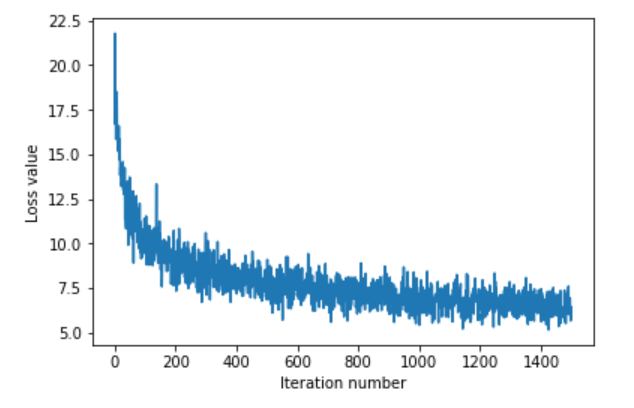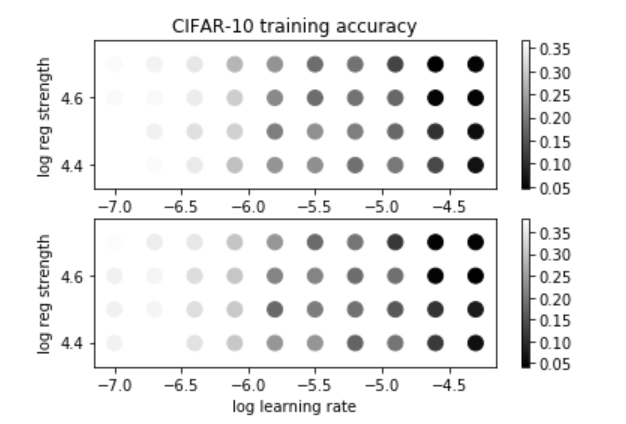cs231n assignment1(SVM)
实验相关cs231n课程教程:Linear classification: Support Vector Machine, Softmax
这个实验是,用线性分类器SVM ,在CIFAR-10数据集上做图像分类。
关于CIFAR-10数据集的介绍,移步这里。
(!!此处应该有个超链接!!)
关于支持向量机SVM的介绍,移步这里。
(!!此处应该有个超链接!!)
线性模型
线性模型非常简单
对于CIFAR-10数据集来说,$x_i$的维度是$[1\times3072]$,$W$的维度是$[3072\times10]$,$b$是$[1\times10]$。
使用bias trick之后(参考课程教程),$x_i$的维度变为$[1\times3073]$,$W$变为$[3073\times10]$,模型如下。
模型得到的是一个$[1\times10]$的分数矩阵,分数最高的类别就是学习器的预测结果。
多分类SVM的损失
对于样本$i$,类别$j$的得分为:$s_j=f(x_i,W)_j=(x_iW)_j$。样本$i$的损失为
这是SVM loss的目标是让样本的正确类别的得分要比错误类别的得分高至少$\Delta$。
为不让超平面过拟合,引入正则化项,这里用L2正则化。
总的损失就是这两部分之和
展开就是
损失的梯度推导
接下来就是优化了,采用最常用的梯度下降法。如果尝试课上讲的那种在计算图上求导感觉会有点乱。
正则化向的导数
前面每个样本的的每个分类的得分损失
可以看到有多个部分对$w_j^T$的导数都有贡献。$\frac{\partial{f}}{\partial{w^T_j}}=\sum_k\frac{\partial{f}}{\partial{p}_k}\cdot\frac{\partial{p_k}}{\partial{w^T_j}}$
对每个$L_{i,j},j\neq y_i$,有
计算损失&梯度(code)
two_loops
two_loops的公式上文已经推出,下面是实现。
1 | def svm_loss_naive(W, X, y, reg): |
one_loop
1 | def svm_loss_one_loop(W, X, y, reg): |
no_loop
1 | def svm_loss_vectorized(W, X, y, reg): |
随机梯度下降
每次随机选一小部分mini_batch进行样本进行梯度下降。随机梯度下降的过程中,损失函数局部应该会有小的波动,但总体还是呈下降趋势。如图,

标准梯度下降,每次一定会下降。但是每次迭代对所有样本进行计算,计算量大。损失曲线比较平滑。如图,

np.random.choice(num, batch_size, replace=False)在[0,num-1]中抽取
batch_size个数字replace=false表示不放回抽取。
线性分类器随机梯度下降的核心代码1
2
3
4
5
6
7
8
9
10
11
12
13
14
15loss_history = []
for it in range(num_iters):
sample_index = np.random.choice(num_train, batch_size, replace=False)
X_batch = X[sample_index, :] # select the batch sample
y_batch = y[sample_index] # select the batch label
# evaluate loss and gradient
loss, grad = self.loss(X_batch, y_batch, reg)
loss_history.append(loss)
self.W += -learning_rate * grad
if verbose and it % 100 == 0:
print('iteration %d / %d: loss %f' % (it, num_iters, loss))
return loss_history
步长&正则化常数调参
步长的范围是$[1e-7,5e-5]$,一般是等比增加的;
正则化的范围是$[2.5e4,5e4]$,这里采用等差增加。
最后在validation中的分数大概是0.38。(据说用心调可以到0.4左右,大概多取些值耐心等吧)1
2
3
4
5
6
7
8
9
10
11
12
13
14
15
16
17
18
19
20
21
22
23
24
25
26
27
28
29
30
31learning_rates = [1e-7, 5e-5]
regularization_strengths = [2.5e4, 5e4]
results = {}
best_val = -1
best_svm = None
# chooses the best hyperparameters by tuning on the validation
learning_rates = np.log10(learning_rates)
for lr in np.logspace(learning_rates[0], learning_rates[1], 10):
print("now padding: " + str(lr))
for reg in np.linspace(regularization_strengths[0], regularization_strengths[1], 4):
print("now_reg:" + str(reg))
svm = LinearSVM()
loss_hist = svm.train(X_train, y_train, learning_rate=lr, reg=reg,
num_iters=500, verbose=True)
y_train_pred = svm.predict(X_train)
y_val_pred = svm.predict(X_val)
train_acc = np.mean(y_train == y_train_pred)
val_acc = np.mean(y_val == y_val_pred)
results[(lr, reg)] = (train_acc, val_acc)
if val_acc > best_val:
best_val = val_acc
best_svm = svm
# Print out results.
for lr, reg in sorted(results):
train_accuracy, val_accuracy = results[(lr, reg)]
print('lr %e reg %e train accuracy: %f val accuracy: %f' % (lr, reg, train_accuracy, val_accuracy))
print('best validation accuracy achieved during cross-validation: %f' % best_val)
结果看一下图吧。
(上图训练集结果;下图验证集结果)